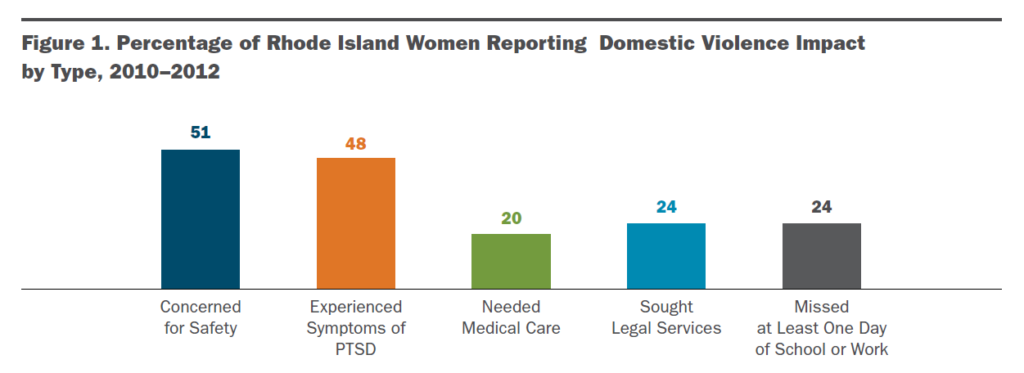Improving Domestic Violence Responses in Rhode Island
Improving Domestic Violence Responses in Rhode Island
Despite an overall drop in crime, domestic violence remains a persistent problem in Rhode Island. However, the full impact of domestic violence in the state remains unknown. There is no centralized statewide tracking of domestic violence-related data, and domestic vio¬lence policies and practices in the state are ambiguous and inconsistent. In 2020, the Rhode Island Department of Corrections received a competitive grant from BJA to address domestic violence in the state. The state then contracted with the CSG Justice Center to assess domestic violence responses and recommend improved policies and practices. This brief provides an overview of domestic violence trends in Rhode Island and how they are being addressed through the Justice Reinvestment Initiative.
Background
Despite an overall drop in crime,¹ domestic violence remains a persistent problem in Rhode Island. Mirroring national trends, the state reports that over 32 percent of women and more than 25 percent of men have experienced domestic violence in their lifetimes.² Each year, thousands of domestic violence victims and survivors seek services from domestic violence agencies across the state.³ Domestic violence crimes also comprise a large portion of arrests and court cases, and domestic violence is a prevalent offense among incarcerated individuals statewide.4 Domestic violence necessitates a vast amount of resources in systems-based as well as community-based responses. Though the extensive personal and communal effects of domestic violence are not always recognized, they include issues related to safety as well as mental and physical health, with individuals and communities often left to respond to domestic violence with limited resources.5
The full impact of domestic violence in the state remains unknown. There is no centralized statewide tracking of domestic violence-related data (including arrests, diversion, convictions, treatment, and recidivism), and domestic violence policies and practices in the state are ambiguous and inconsistent. Further, data that are currently collected do not include individuals who experience domestic violence but do not engage with the criminal justice system. These gaps in statewide tracking and data collection limit Rhode Island’s ability to account for domestic violence prevalence and response, threatening the public safety of individuals and communities affected by domestic violence.
In the spring of 2019, staff from The Council of State Governments (CSG) Justice Center, with support from the U.S. Department of Justice’s Office of Justice Programs, Bureau of Justice Assistance (BJA) responded to the Rhode Island Department of Corrections’ (RIDOC) request to conduct a comprehensive assessment of the state’s batterer intervention programs (BIP). These programs are designed to help people who commit domestic violence learn new patterns of behavior. The assessment revealed that despite Rhode Island’s progress in improving programming consistency, oversight, and standardization to address domestic violence, systemic challenges remained. Accordingly, in 2020, RIDOC received a competitive grant from BJA to address domestic violence in the state. The state then contracted with the CSG Justice Center to assess domestic violence responses and recommend improved policies and practices.
Emphasizing coordinated community responses, this project encompasses a systemic approach to domestic violence reform in Rhode Island that aims to support victims and survivors within and outside of the criminal justice system. This project also seeks to emphasize accountability and examine resources for people who have committed domestic violence. CSG Justice Center staff, with guidance from RIDOC and other state agencies, are conducting a comprehensive analysis of domestic violence responses in Rhode Island. Part of this effort includes conducting focus groups and interviewing key stakeholders involved in Rhode Island’s domestic violence response to create a more holistic picture of statewide domestic violence trends, understand the experiences of people responding to domestic violence, and underscore the vast range of victim and survivor identities and experiences. CSG Justice Center staff will seek to analyze any existing disparities in policies, programs, and practices through both qualitative and quantitative data analyses.
Analyses will explore differences in domestic violence prevalence, service engagement, accessibility, and outcomes. This work will build upon the previous analysis of BIP programming in Rhode Island by exploring systemic and programmatic issues impacting service accessibility, delivery, and outcomes. This includes further evaluating the type of BIP programming offered, who is receiving it, its impact, and the extent to which it is evidence informed and culturally responsive.
Based on the findings from these quantitative and qualitative analyses, research on established or emerging evidence-informed practices in the field of domestic violence, and input from CSG Justice Center experts, an Executive Working Group, convened by the governor and composed of interdisciplinary leaders from statewide organizations and agencies, will develop policy options that are designed to improve outcomes for all victims and survivors while also addressing the needs of people who commit domestic violence. These policy options will ultimately increase public safety by allowing the state to reinvest in strategies that can reduce domestic violence while improving and expanding domestic violence service provision. Policy options may include formalized legislative efforts as well as localized community programmatic responses.
Domestic Violence Trends in Rhode Island
This overview highlights recent domestic violence trends in Rhode Island. Information presented here is based on Rhode Island statutes, publicly available reports from Rhode Island state agencies, or federal reports. Due to limitations of publicly available data, the years represented in the data presented may vary.
It is vital to underscore that data shown here represent one dimension of the narrative about domestic violence experiences and responses in Rhode Island. Though indicative of larger trends, each statistic reflects the individual lives of the people who are impacted by domestic violence. Their stories are complex, unique, and extend far beyond a data point. In reviewing these numbers, it is also imperative to consider those individuals who have experienced and are experiencing domestic violence whose stories are not captured here. Those who are forgotten in outreach, who cannot or choose not to engage with formalized systems of support, or who have not identified that they are experiencing domestic violence continue to be impacted and must be recognized in future policy and practice innovations and reforms.
Despite substantial declines in overall crime since the 1990s,6 domestic violence7 continues to impact the health and public safety of Rhode Islanders.8 However, due to data limitations, the full prevalence of domestic violence in Rhode Island is unknown.
■ The National Intimate Partner Violence Survey (NISVS), conducted between 2010 and 2012, indicated that 1 in 3 women and 1 in 4 men in Rhode Island had experienced domestic violence in their lifetimes.9
■ Self-reported prevalence of domestic violence in Rhode Island has not been measured in approximately a decade; the most recent survey data were collected between 2010 and 2012.10 Alarmingly, national research suggests that domestic violence incidences have spiked in the last two years due to lockdowns related to COVID-19.11
■ All victims of domestic violence may face harmful consequences, though in Rhode Island, due to limited reported prevalence for men, data on such harms exist only for women. As illustrated in Figure 1, women who reported at least one impact of domestic violence by an intimate partner in the NISVS experienced a wide range of harmful impacts.12
■ Data are not available on other demographic characteristics of people who experience domestic violence in Rhode Island, such as race, ethnicity, socioeconomic status, sexual orientation, immigration status, or disability status. However, national data suggest that individuals in American Indian or Alaskan Native, Black or African American, mixed-race, low-income, LGBTQ+, immigrant, and disability communities are at a heightened risk for violence while facing disproportionate barriers to service provision.13
■ Data also fail to account for the experiences of transgender or gender-nonconforming individuals. However, national data suggest that individuals in these communities are at a higher risk for domestic violence and face substantial barriers in seeking help due to stigma and discrimination, criminalization of their identities, and lack of responsive services14
■ Domestic violence victims and survivors often experience intersecting forms of violence and abuse. Data from the National Intimate Partner and Sexual Violence Survey conducted in 2015 indicate that approximately 18 percent of women experiencing domestic violence reported sexual victimization, and 10 percent reported stalking.15 Human trafficking also remains a prominent concern in domestic violence cases, with human trafficking victims and survivors reporting experiences with domestic and sexual violence.16
■ Domestic violence also has implications for children; many families experiencing domestic violence interface with child welfare systems due to issues of potential abuse, maltreatment, or neglect. An estimated 57 percent of children who reported witnessing violence between intimate partners reported that they had experienced maltreatment.17
Although the full impact of domestic violence in Rhode Island is unknown, data from victim service providers suggest that the need for services has grown in recent years.
■ The Rhode Island Coalition Against Domestic Violence (RICADV) reports that between 2012 and 2020, there was a 27 percent increase in domestic violence hotline calls, a 34 percent increase in the number of children and adults in transitional/safe homes, and a 48 percent increase in counseling services provided to victims and survivors of domestic violence. The number of children served during this time increased by 710 percent. In 2020, domestic violence agencies answered 17,690 hotline calls and provided 45,543 individual services to 9,259 victims and survivors, 486 of whom were children.18
■ Among individuals accessing the Rhode Island Victims’ Services Program—which responds to a range of victimization of crimes including assault, child physical and sexual abuse, adult sexual assault, DUI/DWI, and others— domestic violence was the most reported type of victimization. In 2016, domestic violence survivors represented 43 percent (11,671) of all victims served.19
■ The Rhode Island Supreme Court Domestic Violence and Sexual Assault Training and Monitoring Unit forms show that numbers of domestic violence calls to law enforcement in Rhode Island have remained stable in recent years, while rates of on-the-scene arrest have increased by 10 percent since data were first recorded in 2007.20 However, it is unclear who is impacted by arrest.
■ In 2015, police responded to 7,678 domestic violence service calls, 73 percent of which were deemed to have probable cause for violence and resulted in at least one arrest.21 The demographics of the people arrested are of concern, as national data suggest that women, LGBTQ+ individuals, and Black and Latino individuals in states with mandatory arrest policies in cases of domestic violence, such as Rhode Island, are disproportionately arrested even when they are victims of violence.22
■ The number of domestic violence victims and survivors who do not engage law enforcement in Rhode Island is unknown, though national survey data show that over half of 637 women interviewed (51 percent) had not involved law enforcement in cases of domestic violence. Issues such as fear of reprisal from a partner, treatment based on race or ethnicity, disability status, long-term negative consequences for their partner, and other issues can complicate an individual’s ability or desire to involve law enforcement.23
Domestic violence offenses account for a large portion of misdemeanor charges and convictions in Rhode Island, though other trends related to domestic violence offenses and convictions are unclear.24
■ In 2021, domestic assault was the most common misdemeanor offense among men held pretrial, and domestic disorderly conduct was the most common misdemeanor offense for women held pretrial.
■ As noted in Figure 2, the proportion of domestic assault misdemeanor offenses among men has increased in recent years.25 Domestic assault (14 percent) and violation of a no-contact order (12 percent) were the most common misdemeanor offenses for sentenced men, and domestic disorderly conduct (22 percent) was the most common misdemeanor offense for sentenced women in Rhode Island from 2017 to 2021.26
■ In 2019, 14 percent of people (980) on probation or parole in the state were convicted of a misdemeanor domestic violence offense.27
■ Available data do not illuminate how many individuals have multiple misdemeanor domestic violence charges, nor is information available about relationships between misdemeanor and felony charges over time. Thus, it is difficult to examine patterns or escalations of violence.
■ The number of domestic violence survivors who are also charged with domestic violence offenses in Rhode Island is unknown. National research suggests that women, in particular, are likely to have experienced domestic violence prior to criminal justice system involvement, including women convicted of domestic violence offenses.28
Incidences of domestic violence homicide within the state have more than tripled in recent years.29
■ Between 2006 and 2015, 54 people were victims of domestic violence homicides in Rhode Island; 72 percent of these homicides were committed by an intimate partner.30
■ Firearms are the leading weapon used in Rhode Island’s intimate partner homicides. Between 2006 and 2015, 42 percent of intimate partner homicides were committed with firearms.31
■ Individuals experiencing domestic violence were at the highest risk for death when planning to leave the relationship or immediately following separation. In 54 percent of Rhode Island’s intimate partner homicide cases, the victim was estranged or planning to leave the relationship as evidenced by friend or family testimonies, legal proceedings, or other evidence indicating the victim was pursuing separation.32 This percentage is likely an underestimate, as it does not account for cases in which only the victim and the partner who killed them were aware of a separation.
■ Over half (51 percent) of the people who committed domestic violence homicides had no previous domestic violence charges.33 Histories of violence in these cases are not always known due to the lack of data on experiences outside of the criminal justice system.
■ Minimal demographic information accompanies Rhode Island domestic violence homicide statistics, which limits the ability of individuals, communities, and organizations to identify and reach populations who may be at elevated risk of death.
Rhode Island family, district, and superior courts respond to large volumes of domestic violence cases each year.
■ In 2020, Rhode Island’s Special Victims Unit witnessed an uptick in felony domestic violence cases. Prosecutors carried an average of 167 felony cases (a 26 percent increase from 2019) including domestic murder, felony assault, and sexual assault.34
■ In 2020, domestic abuse comprised 5 percent of total filed court cases in family court (1,759 of 11,106 cases). The same year, the district court system issued 638 orders to surrender firearms in civil domestic abuse cases.35
■ In 2019, Pretrial Services received 1,283 domestic violence cases and monitored the conditions of bail for defendants charged with domestic violence offenses. Of these cases, 75 percent were felonies. The same year, Pretrial Services also began utilizing a Domestic Violence Screening Instrument to assess danger and deemed the people who committed nearly half of cases (584) high risk.36
Though Rhode Island has made significant progress in improving services for people who commit domestic violence, the state continues to face programmatic and systemic challenges.
■ In BIP, there is no consistent practice of conducting risk and/or needs assessments, nor is there differentiation in programming among clients. Individuals with varying histories, risk levels, and issues are given identical programming. Further, instructors typically rely on self-reported data from clients on histories of violence, levels of risk, and presenting problems. These issues continue to challenge the efficacy of programming.37
■ BIP group facilitation varies highly among programs. The use of a BIP curriculum is inconsistent, and there is a lack of gender-responsive programming. The curriculum, if offered at all, is thus extremely varied in quality, content, and appropriateness and cannot be comparatively measured or evaluated.38
■ Among systemwide agencies, such as law enforcement, courts, prosecutors, and others, there is a lack of consistent cross-training on domestic violence issues, data sharing practices, and sentencing disparities. These systemic issues impact efficacy of the state’s response to domestic violence.39
Victim service providers in Rhode Island face fluctuating funding and gaps in services.
■ As is the case nationally, Victims of Crime Act funding has continued to decrease in the state. In 2021, Rhode Island was allocated approximately $3.7 million, representing a more than $2 million decrease in funding allocations from the previous year, constraining the delivery of domestic violence services.40
■ Rhode Island’s Violence Against Women Act funding has fluctuated in recent years but experienced an approximate $6,000 decrease between 2019 and 2020. Continued disinvestment has the potential to impact domestic violence and sexual assault programming provision, culturally specific services, domestic violence and sexual assault training, and specialized law enforcement and court offices.41
■ A 2017 needs assessment and gap analysis revealed that prominent issues remain for victims, including service accessibility, culturally competent services, housing and health challenges, and long-term supports.42
■ Rhode Island Governor Daniel McKee’s fiscal year 2023 state budget includes $4.5 million allocated for support for survivors of domestic violence.
The Justice Reinvestment Initiative Approach
Step 1:
Analyze data and develop policy recommendations
Using hundreds of thousands of individual state-and county-level records, CSG Justice Center staff, in collaboration with RIDOC, are conducting a comprehensive analysis of arrest patterns and behavioral health data as well as rates of domestic violence incidence, conviction, sentencing, probation, incarceration, parole, recidivism, and service provision. Additionally, CSG Justice Center staff are examining structural issues, such as changes in BIP funding; the design, delivery, and accessibility of programming for victims and people who commit domestic violence; and high rates of community supervision revocation to understand the capacity of current community-based domestic violence programming as well as gaps in services.
Analyses seek to highlight the experiences of victims and survivors who engage with the criminal justice system as well as those who do not in order to provide holistic, responsive recommendations. To gather cross-disciplinary perspectives from individuals and communities across Rhode Island, CSG Justice Center staff are seeking input from stakeholders impacted by domestic violence. These stakeholders include victims and survivors, people who commit domestic violence, victim advocates, pretrial services and treatment providers, law enforcement, tribal entities, court administrators, judges, prosecutors, defense counsel, corrections staff, and other entities that engage with domestic violence work.
With the assistance of CSG Justice Center staff, designees from organizations and agencies represented in the Executive Working Group will review the analyses focused on reducing the incidence and prevalence of domestic violence in Rhode Island and increasing public safety. Policy recommendations will be available for the Executive Working Group’s consideration in January 2023, and the recommendations they approve will then be provided to the legislature. Recommendations for improved policies and practices will also be provided to organizations and agencies whose work involves issues of domestic violence.
Step 2:
Adopt new policies and put reinvestment strategies into place
CSG Justice Center staff will partner with Rhode Island policymakers, organizations, and community members to adopt policy and practice recommendations to address domestic violence challenges. This will include implementing changes to existing policies and procedures as well as expanding innovative ideas and evidence-based strategies. Metrics for outcome measurement—emphasizing fidelity, accountability, and sustainability—will also be determined as policies are translated into practice. CSG Justice Center staff will develop implementation plans with state and local entities and provide stakeholders with frequent progress reports.
Step 3:
Measure performance
CSG Justice Center staff will help state and local stakeholders in Rhode Island improve statewide data collection and information sharing. Partners will monitor internal changes, measure programmatic improvements, communicate implementation obstacles and opportunities, and share results. These efforts will increase Rhode Island’s capacity for making data-driven decisions on domestic violence policymaking, program provision, and budgeting while continuing to develop and strengthen collaborative working relationships within and among communities impacted by domestic violence.
Endnotes
1. Steven M. Pare et al., 2000 Crime in Rhode Island Uniform Crime Reports (North Scituate: Rhode Island State Police, 2000), https://risp.ri.gov/documents/UCR/2000.pdf; Laurie Ludovici et al., 2020 Uniform Crime Report Crime in Rhode Island (North Scituate: Rhode Island State Police, 2020), https://risp.ri.gov/documents/UCR/2020.pdf.
2. Sharon G. Smith et al., The National Intimate Partner and Sexual Violence Survey: 2010–2012 State Report (Atlanta: Centers for Disease Control and Prevention, National Center for Injury Prevention and Control, 2017), https:// www.cdc.gov/violenceprevention/pdf/nisvs-statereportbook.pdf.
3. Rhode Island Coalition Against Domestic Violence, Rhode Island Coalition Against Domestic Violence Annual Report, 2020 (Warwick: Rhode Island Coalition Against Domestic Violence, 2021), http://www.ricadv.org/images/ Annual_Reports/RICADV_2019_Annual_Report.pdf; Sojourner House, 2020 Annual Report (Providence: Sojourner House, 2021), https://www.sojournerri. org/wp-content/uploads/2021/06/Sojo-2020-annual-report.pdf.
4. Rhode Island Judiciary, Annual Report 2020 (Providence: Rhode Island Judiciary, 2019), https://www.courts.ri.gov/PublicResources/annualreports/ PDF/2020.pdf; Domestic Violence Training and Monitoring Unit, Domestic Violence Cases (Providence: Rhode Island Judiciary, 2018), https://www.courts. ri.gov/PublicResources/domesticviolenceunit/DVCaseDocuments/DVTMU. DV01-2015.pdf; Rhode Island Department of Corrections, Fiscal Year 2021 Annual Population Report (Providence: Rhode Island Department of Corrections, 2021), file:///Users/cmurray/Downloads/fy21-annual-population-report-final-directors-changes.pdf.
5. Smith et al., The National Intimate Partner and Sexual Violence Survey: 2010– 2012 State Report.
6. Pare et al., 2000 Crime in Rhode Island Uniform Crime Reports; Ludovici et al., 2020 Uniform Crime Report Crime in Rhode Island.
7. Domestic violence is defined as the physical, sexual, and/or emotional maltreatment of one family member by another (APA 1996). Although the term domestic violence is often used interchangeably with the term intimate partner violence (IPV), domestic violence is a broader category. It typically includes all forms of family violence, such as elder abuse, child abuse, and IPV. IPV refers to acts of physical, sexual, and/or emotional aggression between intimate partners in particular (see https://www.cdc.gov/violenceprevention/intimatepartnerviolence/). From a legal standpoint, only certain forms of domestic violence or IPV are crimes (e.g., physical harms or threats). American Psychological Association, Violence, and the Family: Report of the APA Presidential Task Force on Violence and the Family (Washington, DC: American Psychological Association, 1996).
8. Pare et al., 2000 Crime in Rhode Island Uniform Crime Reports; Ludovici et al., 2020 Uniform Crime Report Crime in Rhode Island.
9. Smith et al., The National Intimate Partner and Sexual Violence Survey: 2010– 2012 State Report.
10. Ibid.
11. Alex R. Piquero et al., Domestic Violence During COVID-19: Evidence from a Systematic Review and Meta-Analysis (Washington, DC: Council on Criminal Justice, 2021), https://cdn.ymaws.com/counciloncj.org/resource/resmgr/ covid_commission/Domestic_Violence_During_COV.pdf.
12. Smith et al., The National Intimate Partner and Sexual Violence Survey: 2010–2012 State Report.
13. Ibid.; Disa K. V. Lubker, “Socioeconomic Status and Domestic Violence,” International Journal of Global Health and Health Disparities 3, no. 1 (2004): 85; Marlene Matos and Mariana Gonçalves, “Prevalence of Violence against Immigrant Women: A Systematic Review of the Literature,” Journal of Family Violence 31, no. 6 (2016): 697; Matthew J. Breiding and Brian S. Armour, “The Association Between Disability and Intimate Partner Violence in the United States,” Annals of Epidemiology 25, 6 (2015): 455.
14. Sandy E. James et al., The Report of the 2015 U.S. Transgender Survey (Washington, DC: National Center for Transgender Equity, 2015), https:// transequality.org/sites/default/files/docs/usts/USTS%20Full%20Report%20 -%20FINAL%201.6.17.pdf; Kristie L. Seelman, “Unequal Treatment of Transgender Individuals in Domestic Violence and Rape Crisis Programs,” Journal of Social Service Research 41, no. 3 (2015): 307.
15. Sharon G. Smith et al., The National Intimate Partner and Sexual Violence Survey: 2015 Data Brief – Updated Release (Atlanta: Centers for Disease Control and Prevention, National Center for Injury Prevention and Control, 2018) https://www.cdc.gov/violenceprevention/pdf/2015data-brief508.pdf.
16. Lori Mann, Female Victims of Trafficking for Sexual Exploitation as Defendants: A Case Law (Vienna: United Nations Office on Drugs and Crime, 2020), https://www.unodc.org/documents/human-trafficking/2020/final_ Female_victims_of_trafficking_for_sexual_exploitation_as_defendants.pdf.
17. Child Welfare Information Gateway, Domestic Violence: A Primer for Child Welfare Professionals (Washington, DC: U.S. Department of Health and Human Services, Administration for Children and Families, Children’s Bureau, 2020), https://www.childwelfare.gov/pubPDFs/domestic_violence.pdf; Sherry Hamby et al., “The Overlap of Witnessing Partner Violence with Child Maltreatment and Other Victimizations in a Nationally Representative Survey of Youth,” Child Abuse and Neglect 34, no. 10 (2010): 734.
18. Rhode Island Coalition Against Domestic Violence, 2020 Annual Report (Warwick: Rhode Island Coalition Against Domestic Violence, 2021) http:// www.ricadv.org/images/Annual_Reports/RICADV_AnnualReport_Website_ version.pdf; Rhode Island Coalition Against Domestic Violence, 2012 Annual Report Surviving and Thriving (Warwick: Rhode Island Coalition Against Domestic Violence, 2012), http://www.ncdsv.org/images/RICADV_ AnnualReport_2012.pdf.
19. Hornby Zeller Associates, Inc., Needs Assessment and Gap Analysis: Rhode Island Victims’ Services Program (Troy: Hornby Zeller Associates, Inc., 2017), https://psga.ri.gov/documents/RI_VOCA_GAP_ANALYSIS.pdf.
20. Domestic Violence Training and Monitoring Unit, Domestic Violence Cases (Providence: Rhode Island Judiciary, 2018), https://www.courts.ri.gov/ PublicResources/domesticviolenceunit/DVCaseDocuments/DVTMU.DV01- 2015.pdf.
21. Ibid.
22. April Pattavina et al., “Comparison of the Police Response to Heterosexual Versus Same-Sex Intimate Partner Violence,” Violence Against Women 13, no. 4 (2007): 374; Alesha Durfee, “Situational Ambiguity and Gendered Patterns of Arrest for Intimate Partner Violence,” Violence Against Women 18, 1 (2012): 64; Leigh Goodmark, “Transgender People, Intimate Partner Abuse, and the Legal System,” Harvard Civil Rights-Civil Liberties Law Review 48 (2013): 151.
23. T.K. Logan and Rob Valente, Who Will Help Me? Domestic Violence Survivors Speak Out About Law Enforcement Responses (Washington, DC: National Domestic Violence Hotline, 2015), http://www.thehotline.org/wp-content/ uploads/sites/3/2015/09/NDVH-2015-Law-Enforcement-Survey-Report.pdf.
24. Rhode Island Department of Corrections, Fiscal Year 2021 Annual Population Report (Providence: Rhode Island Department of Corrections, 2021), file:///Users/cmurray/Downloads/fy21-annual-population-report-final-directors-changes.pdf.
25. Ibid.; Rhode Island Department of Corrections, Fiscal Year 2020 Annual Population Report (Providence: Rhode Island Department of Corrections, 2020), https://doc.ri.gov/sites/g/files/xkgbur681/files/docs/FY20-Annual- Population-Report.pdf; Rhode Island Department of Corrections, Fiscal Year 2019 Annual Population Report (Providence: Rhode Island Department of Corrections, 2019), https://doc.ri.gov/sites/g/files/xkgbur681/files/docs/ FY19-Annual-Population-Report.pdf; Rhode Island Department of Corrections, Fiscal Year 2018 Annual Population Report (Providence: Rhode Island Department of Corrections, 2018), https://doc.ri.gov/sites/g/files/xkgbur681/ files/docs/FY18-Annual-Population-Report—-Feb-2019.pdf; 2017 Annual Population Report (Providence: Rhode Island Department of Corrections, 2017), https://doc.ri.gov/sites/g/files/xkgbur681/files/docs/FY17-Annual-Population- Report.pdf.
26. Ibid.
27. Rhode Island Department of Corrections, “Probation and Parole: Overview of Units,” Rhode Island Department of Corrections, 2021, http://www.doc. ri.gov/community-corrections/probation-parole/units-overview.php.
28. Mary E. Gilfus, Women’s Experiences as a Risk Factor for Incarceration (Harrisburg: National Resource Center on Domestic Violence, 2002), https:// vawnet.org/sites/default/files/assets/files/2017-08/AR_Incarceration.pdf.
29. Rhode Island Coalition Against Domestic Violence, Domestic Violence Homicides in Rhode Island, 2006–2015 (Warwick: Rhode Island Coalition Against Domestic Violence, 2016), http://www.ricadv.org/images/Policy/ RICADV_HomicideReport_final_forweb.pdf.
30. Ibid.
31. Rhode Island Coalition Against Domestic Violence, Domestic Violence Homicides in Rhode Island, 2006–2015.
32. Ibid.
33. Ibid.
34. Rhode Island Office of the Attorney General, Annual Report 2020 (Providence: Rhode Island Office of the Attorney General, 2020), https://riag. ri.gov/media/2411/download?language=en.
35. Rhode Island Judiciary, Annual Report 2020 (Providence: Rhode Island Judiciary, 2021) https://www.courts.ri.gov/PublicResources/annualreports/ PDF/2020.pdf.
36. Rhode Island Judiciary, Annual Report 2019 (Providence: Rhode Island Judiciary, 2020), https://www.courts.ri.gov/PublicResources/annualreports/ PDF/2019.pdf.
37. The Council of State Governments Justice Center, Assessment of Rhode Island Batterer Intervention Programs (New York: The Council of State Governments Justice Center, 2019), internal report.
38. Ibid.
39. Ibid.
40. “OVC FY 21 VOCA Victim Assistance Formula,” The Office for Victims of Crime, access March 22, 2022, https://ovc.ojp.gov/funding/awards/15povc- 21-gg-00596-assi; “OVC FY 20 VOCA Victim Assistance Formula,” The Office for Victims of Crime, accessed March 22, 2022, https://ovc.ojp.gov/funding/ awards/2020-v1-gx-0049.
41. Kevin Barry and Michael J. Hogan, Rhode Island Department of Public Safety Grants Administration Office Annual Report 2020 (North Scituate: Rhode Island Department of Public Safety Grants Administration Office, 2020), https://psga.ri.gov/documents/2020_PSGAO_Annual_Report.pdf; Mary S. McElroy and Michael J. Hogan, Rhode Island Department of Public Safety Grants Administration Office Annual Report 2018 (North Scituate: Rhode Island Department of Public Safety Grants Administration Office, 2018), https://psga. ri.gov/documents/2018_PSGAO_Annual_Report.pdf.
42. Though this report surveys all crime victims utilizing Rhode Island’s Victim Services Unit, domestic violence victims represent over 40 percent of victims seeking services. Hornby Zeller Associates, Inc., Needs Assessment and Gap Analysis: Rhode Island Victims’ Services Program.
This project was supported by Grant No. 2020- ZB-BX-0022 awarded by the Bureau of Justice Assistance. The Bureau of Justice Assistance is a component of the Department of Justice’s Office of Justice Programs, which also includes the Bureau of Justice Statistics, the National Institute of Justice, the Office of Juvenile Justice and Delinquency Prevention, the Office for Victims of Crime, and the SMART Office. Points of view or opinions in this document are those of the author and do not necessarily represent the official position or policies of the U.S. Department of Justice.
The Council of State Governments (CSG) Justice Center is a national nonprofit organization that serves policymakers at the local, state, and federal levels from all branches of government. The CSG Justice Center’s work in justice reinvestment is done in partnership with The Pew Charitable Trusts and the U.S. Department of Justice’s Bureau of Justice Assistance. These efforts have provided data-driven analyses and policy options to policymakers in 26 states. For additional information about Justice Reinvestment, please visit csgjusticecenter.org/jr/.
The mission of the Rhode Island Department of Corrections (RIDOC) is to contribute to public safety by maintaining a balanced correctional system of institutional and community programs that provide a range of custodial options, supervision and rehabilitative services in order to facilitate successful reentry into the community upon release.
Project Contact:
Carly Murray, Senior Policy Analyst, cmurray@csg.org
Project credits
Writing: Carly Murray, CSG Justice Center
Research: Sara Bastomski, CSG Justice Center
Advising: Grace Beil Call, David D’Amora, Shundrea Trotty, Brant Wadsworth, CSG Justice Center
Editing: Leslie Griffin, CSG Justice Center
Public Affairs: Brenna Callahan, CSG Justice Center
Web Development: Catherine Allary, CSG Justice Center
About the author

Arkansas policymakers have long expressed concerns about the state’s high recidivism rate. Over the past 10 years, an…
Read MoreIn April 2025, Arkansas Governor Sarah Huckabee Sanders signed a package of bipartisan criminal justice legislation into law,…
Read More Explainer: Key Findings and Options from Arkansas’s Justice Reinvestment Initiative
Explainer: Key Findings and Options from Arkansas’s Justice Reinvestment Initiative
Arkansas policymakers have long expressed concerns about the state’s high recidivism rate.…
Read More Explainer: How a New Law in Arkansas Tackles Crime, Recidivism, and Community Supervision Challenges
Explainer: How a New Law in Arkansas Tackles Crime, Recidivism, and Community Supervision Challenges
In April 2025, Arkansas Governor Sarah Huckabee Sanders signed a package of…
Read More














